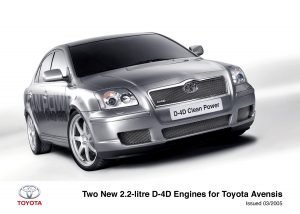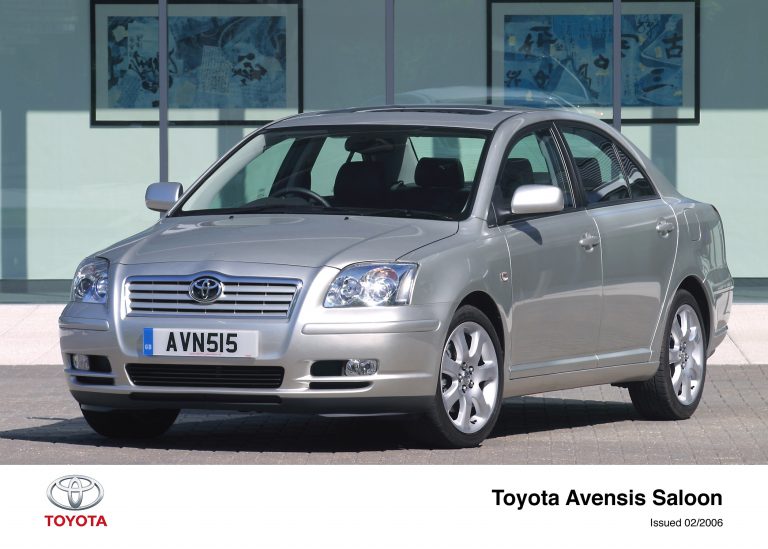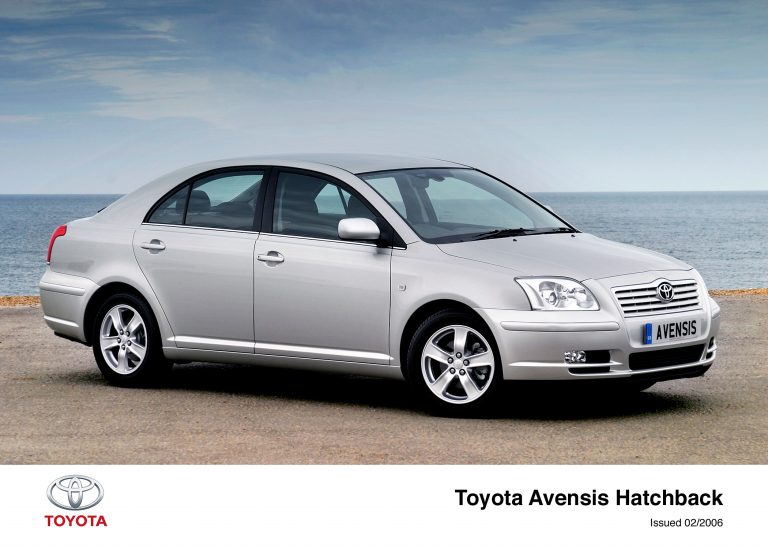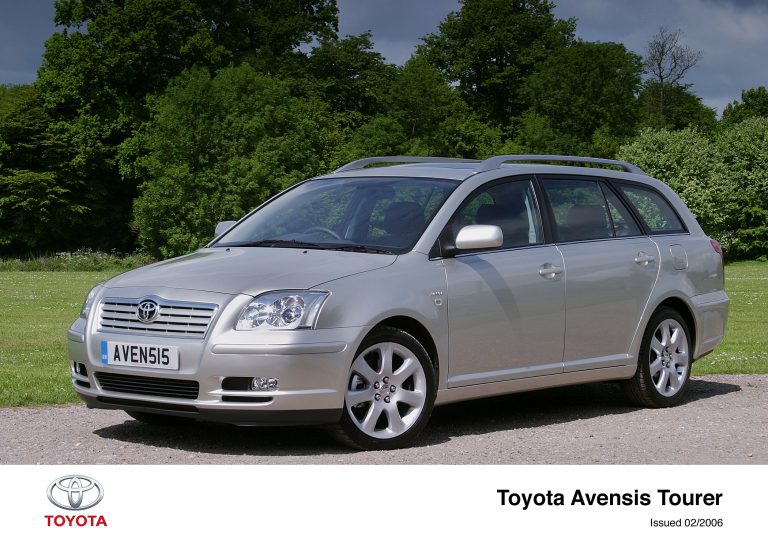The New Toyota Avensis 2.2-Litre D-4D And D-4D Clean Power Engines
Effortless performance with superior quality
KEY POINTS
- Two new 2.2-litre D-4D engines for Toyota Avensis presented at the Geneva Motor Show
- 2.2-litre D-4D
- Maximum power 148bhp and 310Nm from 2,000 to 3,200rpm
- Lightweight all-aluminium construction
- New, compact six-speed manual transmission
- Targeted top speed of 130mph and 0-62mph in 9.3 seconds
- Targeted combined fuel consumption of 47.1mpg and CO2 emissions of 157g/km
- Available in the UK from June 2005
- 2.2-litre D-4D Clean Power
- On sale in the UK in early 2006
- Class-leading performance: 175bhp and 400Nm from 2,000 to 2,600rpm
- Combined fuel consumption on average 20 per cent lower than rival engines with similar output (target figure)
- Lighter than most engines in segment, 11 per cent lighter than current 2.0-litre D-4D unit
- World’s lowest compression ratio for a production diesel engine, 15.8:1, aiding quieter operation and better performance from start-up
- Electrically-activated turbocharger with turbine wheel inertia reduced by 30 per cent for quicker engine response
- Toyota D-CAT system makes engine the cleanest on the market for combined nitrogen oxides (NOx) and particulate matter (PM) emissions
- Class-leading cost of ownership profile
INTRODUCTION
The Avensis has been a hugely successful car for Toyota in Europe. Now its driver appeal is to be increased with the introduction of two new 2.2-litre D-4D diesel engines. These will give the Avensis one of the most comprehensive product ranges in the D segment with three diesel (2.0, 2.2 148bhp and 2.2 175bhp) and four petrol (1.6, 1.8, 2.0 and 2.4) units. Toyota also builds on the Avensis’s achievement by offering an engine range fully compliant with Euro IV emissions standards, right from day one.
The first of the two new diesels to reach the UK market will be a 148bhp 2.2-litre D-4D unit. This uses a second generation common rail system to help achieve an excellent balance of performance and economy. The engine’s preliminary performance figures show 0-62mph acceleration in 9.3 seconds and combined cycle fuel consumption of 47.1mpg.
The second phase of the new diesel engine development will come in early 2006 with the introduction in the UK of a 175bhp version of the 2.2-litre D-4D that will launch Toyota’s revolutionary new concept for diesel engines, Clean Power. Clean Power features some of the world’s most innovative diesel technologies, some of them unique to Toyota.
Thanks to the incorporation of Toyota D-CAT (Diesel Clean Advanced Technology), the 2.2-litre D-4D Clean Power has the lowest combined NOx and PM emissions of any production diesel engine. At the same time, the engine also offers segment-leading levels of power and torque, 175bhp and 400Nm between 2,000 and 2,600rpm; the lowest levels of noise, vibration and harshness (NVH); and on average 20 per cent lower fuel consumption than engines of equivalent power output (target combined fuel consumption for the saloon model is 46.3mpg).
The two engines are being introduced together in other European markets, but in the UK their launch is to be staggered with the more powerful 2.2-litre D-4D Clean Power engine set to join the Avensis range at a later stage in the model’s life cycle. This decision takes into account the particular market conditions for D segment diesels in this country and the different specification structure for UK Avensis models.
TOYOTA 2.2-LITRE D-4D ENGINE
The first of Toyota’s new 2.2-litre D-4D engines to arrive in the UK market will be the standard 148bhp unit, joining the established 114bhp 2.0-litre D-4D in the Avensis range. In common with all other engines, petrol and diesel, powering the Avensis, the new unit complies with Euro IV emissions standards.
Owners will reap big benefits in terms of performance, refinement and running costs. Preliminary data for the new engine indicate a 130mph top speed and nought to 62mph acceleration in 9.3 seconds, while targeted figures for combined cycle fuel consumption and carbon dioxide emissions are 47.1mpg and 157g/km (hatchback and saloon versions).
Toyota is pushing forward diesel engineering by adopting an all-aluminium construction for the new 2.2-litre D-4D. The subsequent weight saving over the more conventional iron build design helps contribute to the engine’s strong performance profile.
In common with the more powerful 2.2-litre D-4D Clean Power, the engine is matched to a new six-speed manual transmission that is compact and offers smoother and more precise gear changes.
TOYOTA 2.2-LITRE D-4D CLEAN POWER
The new 2.2-litre D-4D Clean Power is lighter than most engines in its class (1.9 to 2.2-litre), thanks to its all-aluminium construction, something that is still rare among diesel engines. Clever engineering measures include integration of the water and oil pump on the chain cover, reducing the oil pump’s weight by five per cent and its volume by 20 per cent. This contributes to making the engine 11 per cent lighter overall than the Avensis’s 2.0-litre D-4D engine.
WORLD-BEATING EMISSIONS CONTROL SYSTEM
The new 2.2-litre D-4D Clean Power engine uses the revolutionary Toyota D-CAT system, which renders the high-performance engine the cleanest diesel power unit in the world in terms of combined nitrogen oxides (NOx) and particulate matter (PM) emissions.
D-CAT features a Diesel Particulate NOx Reduction (DPNR) four-way catalyst, the only system in the world which simultaneously reduces NOx and PM via the combination of a NOx-reduction catalyst and a particulate filter.
Effective operation of the DPNR is controlled by the engine management system varying the air-fuel ratio in the exhaust gases. To do this a fifth injector, the Exhaust Port Injector (EPI), injects fuel into the exhaust gas flow at a critical moment, creating the right conditions for the DPNR catalyst to reduce harmful emissions.
CLASS-LEADING COST OF OWNERSHIP
Toyota targets the cheapest running costs in segment for the Avensis, making the car an excellent proposition for fleet operators. Avensis currently has the best insurance rating in the UK (Groups 7 to 12 across the range), thanks to repair costs that are more than 20 per cent less than the segment average (nine mph impact test with 40 per cent offset).
The 2.2-litre D-4D engines match the 2.0-litre unit in terms of cumulative maintenance time after 60,000 miles at 4.2 hours – the lowest figure in the diesel D segment. The new engines also accept mineral oil, which is cheaper than the synthetic or semi-synthetic oil required for some other engines.
TOYOTA 2.2-LITRE D-4D AND D-4D CLEAN POWER PRELIMINARY TECHNICAL SPECIFICATIONS
| ENGINE |
2.2-LITRE D-4D |
2.2-LITRE D-4D CLEAN POWER |
|
| Type |
In-line 4-cylinder with Variable Nozzle Turbocharger and intercooler |
||
| Cylinder head material |
Aluminium |
||
| Engine block material |
Aluminium |
||
| Fuel type |
48 Cetane diesel (or more) |
||
| Injection type |
Direct, common rail, multiple fuel injection |
||
| Injection pressure (bar) |
1,600 |
1,800 |
|
| Emission control system |
Oxidation catalyst |
Toyota D-CAT + oxidation catalyst |
|
| Valve mechanism |
DOHC 16-valve |
||
| Displacement (cc) |
2,231 |
||
| Bore x stroke (mm) |
86.0 x 96.0 |
||
| Compression ratio (:1) |
16.8 |
15.8 |
|
| Max. power (bhp/rpm) |
148@3,600 |
175@3,600 |
|
| Max. torque (Nm/rpm) |
310@2,000-3,200 |
400@2,000-2,600 |
|
| TRANSMISSION | |||
| Drive type |
Front-wheel drive |
||
| Gearbox type |
Six-speed manual |
||
| PERFORMANCE | |||
| Max. speed (mph) |
130 |
137 |
|
| 0-62mph (sec) |
9.3 |
8.6 |
|
| FUEL CONSUMPTION | |||
| Combined* (mpg) | Saloon/hatch |
47.1 |
46.3 |
| Tourer |
47.1 |
45.6 |
|
| CO2 EMISSIONS | |||
| Combined* (g/km) | Saloon/hatch |
157 |
161 |
| Tourer |
159 |
163 |
|
* According to Directive 1999/100/EC
ENDS






